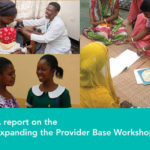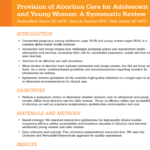Sex workers’ need for safe abortion services in Uganda is greater than that of the population of women of reproductive age because of their number of sexual contacts, the inconsistent use of contraception and their increased risk of forced sex, rape or other forms of physical and sexual violence. This study sought to understand sex workers’ experiences with induced abortion services or postabortion care (PAC) at an urban clinic in Uganda. Nine in-depth interviews were conducted with sex workers. Several important programmatic considerations for safe abortion services for sex workers were identified. Most important is creating community-level interventions in which women can speak openly about abortion, creating a support network among sex workers, training peer educators, and making available a community outreach educator and community outreach workshops on abortion.

A report on the Expanding the Provider Base Workshop hosted by Ipas in 2013. The workshop brought together delegates from nine countries in Africa, Asia and North America and facilitated the sharing of resources and strategies related to expanding the role of non-physician providers in abortion-related care. It details discussion of key topics at the workshop, including the need for and evidence behind expanding cadres of CAC/PAC providers.

A systematic review of 25 studies, covering 346,000 women, to determine whether abortion care for adolescent and young women differs from abortion care for older women—with a focus on efficacy, safety and acceptability. It concludes that limited evidence indicates that abortion of all types at all gestational ages is effective, acceptable and safe for adolescents and young women, and strongly recommends offering adolescents a full range of contraceptives after abortion, including intrauterine contraception.
This publication provides an overview of the neglected sexual and reproductive health needs and rights of migrant, refugee and displaced women.
Where abortion is illegal, women suffer. Before 2002 when abortion was illegal in Nepal, women were imprisoned, half of all hospital admissions were due to complications from clandestine abortions, and hundreds of women died each year.
La negativa por parte de profesionales de la salud a proporcionar servicios a los que se oponen por motivos morales o religiosos es una barrera significativa para el acceso de las mujeres a servicios de aborto seguro y otros servicios de salud reproductiva. Esta publicación contiene recomendaciones para promulgar leyes y reglamentos que salvaguarden el acceso de las mujeres a los servicios a la vez que protejan el derecho de cada profesional de la salud a la objeción de conciencia. Además, proporciona información sobre las normas de derechos humanos que abordan la negativa por parte de profesionales de la salud, así como una lista de recursos adicionales.
The study investigated whether women with etonogestrel implant placement in the immediate postabortion period have similar continuation rates to women with interval placement.The risk of discontinuation in women with postabortion placement was higher but not statistically different than women with interval placement (unadjusted hazard ratio 1.79, 95% confidence interval 0.81-3.96). For women who want a contraceptive implant after an abortion, immediate placement should be available.
The nation’s top court is scheduled to meet Monday to review a constitutional challenge to the country’s abortion laws and to other policies that impede women’s access to a full range of human rights. A positive decision would mean that for the first time in 41 years, Bolivian women meeting certain conditions for an abortion would be free from criminal sanctions.
La articulación entre el enfoque de Derechos Humanos (DH) y la muerte materna como una violación fundamental a los derechos básicos de las mujeres, es un enfoque reciente, innovador y con un gran potencial para promover, defender y garantizar la salud materna y los derechos reproductivos de todas las mujeres en México.
Health care providers play a central role in the promotion and protection of human rights in patient care. Consequently, the World Medical Association, among others, has called on medical and nursing schools to incorporate human rights education into their training programs. This report describes the efforts of one Central American nongovernmental organization to include human rights–related content in reproductive health care provider training programs in Nicaragua and El Salvador. Evaluation findings suggest that exposure to educational materials and methodologies that emphasize the relationship between human rights and reproductive health may lead to changes in health care provider attitudes and behaviors that help promote and safeguard human rights in patient care.
Ipas author response to VSI’s letter to the editor,Osur et al.’s Implementation of misoprostol for postabortion care in Kenya and Uganda: A qualitative evaluation

